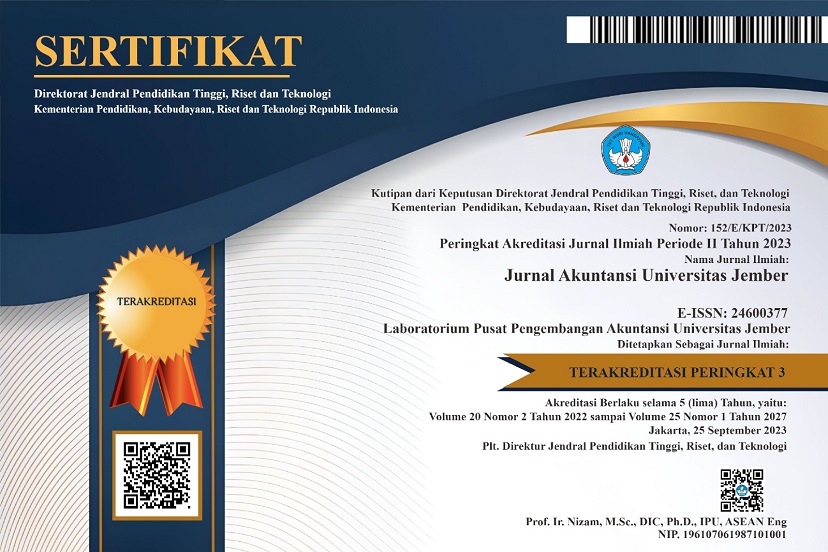CHINESE POVERTY REDUCTION MODEL: A VIRILE TOOL FOR ACHIEVING POVERTY REDUCTION IN NIGERIA BY 2030
DOI:
https://doi.org/10.19184/jauj.v21i1.37087Keywords:
Poverty Reduction, Chinese Model, Agricultural Productivity, Social and Community ExpenditureAbstract
Various strategies have been used by Nigerian government in a bid to stem the tide of rising poverty in the country but poverty appears not to have been abated judging from the available statistics. However, China has been able to reduce its poverty from 57% to less than 1% between 1999 and 2020. Therefore, this study appraised empirically the efficacy of Chinese poverty reduction model reducing poverty in Nigeria. Both the CBN Statistical Bulletin and World Bank Development Indicators were used as sources for the data. The data were analyzed using regression utilizing the Ordinary Least Square method. The results showed that agricultural productivity, a component of China's strategy to combat poverty, had a significant impact on reducing poverty in Nigeria. Additionally, it was discovered that government spending on social services, another Chinese strategy, had a beneficial effect on the eradication of poverty. It was discovered that a 1% increase in the amount spent on social and community services in Nigeria resulted in a 21% decline in the country's poverty rate. However, it was found that agricultural spending was inversely correlated with capital income, which went against the theoretical prediction. Therefore, it was determined that the Chinese model for decreasing poverty, which incorporates better agricultural techniques, higher social security, and community services, will be effective in significantly lowering poverty in Nigeria by 2030.
Keywords: Poverty Reduction, Chinese Model, Agricultural Productivity, Social and Community Expenditure
Downloads
References
Apata, T. (2020). Effect of public spending on agricultural productivity in Nigeria (1981-2018). Revista Galega de EconomÃa 2021, 30 (2), 1-21.
Iheonu, C. O. & Urama, N. E. (2019). Addressing Poverty Challenges in Nigeria. AfriHeritage Policy Brief No. 21, July 2019
Eneji, M. A., Habila, H. & Haruna, F. D. (2019). Impact of government expenditure on agricultural productivity in Nigeria. Sumerianz Journal of Economics and Finance, 2(9), 106-114
Ewubare, D., & Mark, T. (2018). Human capital development and poverty reduction In Nigeria. Journal of Economics and Business, 1(2), 150-163.
Loyce, V. O. & Muturi, W. (2016). The Effect of Government Sectoral Expenditure on Poverty Level in Kenya. Global Journal of Human-Social Science: Economics, 16(2), 1-10.
Mbilinyi, W. & Nyoni, N (2000). Challenges for Civil Society. African Agenda, 3(4) (July/August).
Nosika, A, N. & Ihugba, O. A. (2019). Total government spending on agriculture and its output growth in Nigeria. American Based Research Journal, 8(2), 2304-7151
Odubunmi, A. S. & Omobitan, O. A. (2014). Testing Public Expenditure and Poverty Reduction Nexus in Nigeria. Developing Country Studies, 6(4), 116-122.
Ogebe, O. F., Ali, A., & Olagunju, I. O. (2020). Agricultural production: driver for economic growth and rural poverty reduction in Nigeria. Direct Research Journal of Agriculture and Food Science 8(10), 373-379.
Ogbonna, B. O. (2017). Social welfare scheme; a neglected component of public health care ​services in Nigeria. MOJ Public Health, 5(3), 101‒104
Olaoye, C.O., Olaoye, F.O. & Afolabi, A.J. (2017). Impact of capital budget implementation on economic growth in Nigeria. Global Journal of Management and Business Research: D Accounting and Auditing, 17(3), 9-19.
Olayinka, S. (2019, May 25). 93 million Nigerians now living in Extreme Poverty. Retrieved from The Nation: www.thenationonlineng.net/93-million-nigerians-now-living-in-extreme-poverty/
Omodero, C. O. (2019). Government sectoral expenditure and poverty alleviation in Nigeria. Research in World Economy, 10(1), 80-90.
Oriavwote, V.E. & Ukawe, A. (2018). Government Expenditure and Poverty Reduction in Nigeria. Journal of Economics and Public Finance, 4(2), 156-153.
Ozoana, I. F. (2011). The impact of public spending on poverty reduction in Nigeria [1980-​2011]. Bachelor Degree Project, Caritas University Amorji-Nike Emene Enugu State.
Samson, B. (2021). Help! There’s hunger in the land. Retrieved from https://www.premiumtimesng.com/opinion/496637-the-hunger-republic-of-nigeria-by-​dakuku-peterside.html
Simeon, G. N., Isimekhai, Z. A., Bariika, N. V. & Edafe, E. O. (2021). An empirical investigation of government spending in primary school enrolment and poverty reduction in Nigeria. International Journal of Research in Humanities and Social Studies, 8(6),1-10
Sarısoy, I. & Koç, S. (2010). Türkiye’de kamu transfer harcamalarının yoksulluğuazaltmadaki etkilerinin ekonometrik analizi, Maliye Dergisi, 158(1), 326-348.
Schmidt, L. (2021). China Reduced its Poverty 2021. Retrieved from https://borgenproject.org/china-reduced-its-poverty/
UNDP. (2016). Human Development Report: Human Development for everyone. New York: ​UNDP. http:// hdr.undp.org/sites/default/files/2016_human_devel opment_report.pdf
Uremadu, S. O., Ariwa, F. O. & Uremadu, C. E. (2014). Impact of government agricultural expenditure on agricultural productivity in Nigeria. Current Investigations in Agriculture and Current Research, 5(3), 23-33. https://doi.org/10.32474/CIACR.2018.05.000215
Weolebo, T. F. (2018). The Impact of agricultural expenditure on economic growth in sub saharan African countries (Ssa). Retrieved from https://archives.kdischool.ac.kr/handle/11125/32308
World Bank (2018). Investing in Human Capital for Nigeria’s Future. Retrieved from https://datatopics.worldbank.org
World Bank (2019), Systematic Country Diagnostics (forthcoming). Retrieved from https://datatopics.worldbank.org
World Bank (2021). Global poverty report. Retrieved from ​https://datatopics.worldbank.org/sdgatlas/goal-1-no-poverty/
World Bank (2020). Annual Statistical Bulletin. Abuja, Nigeria: Author


















